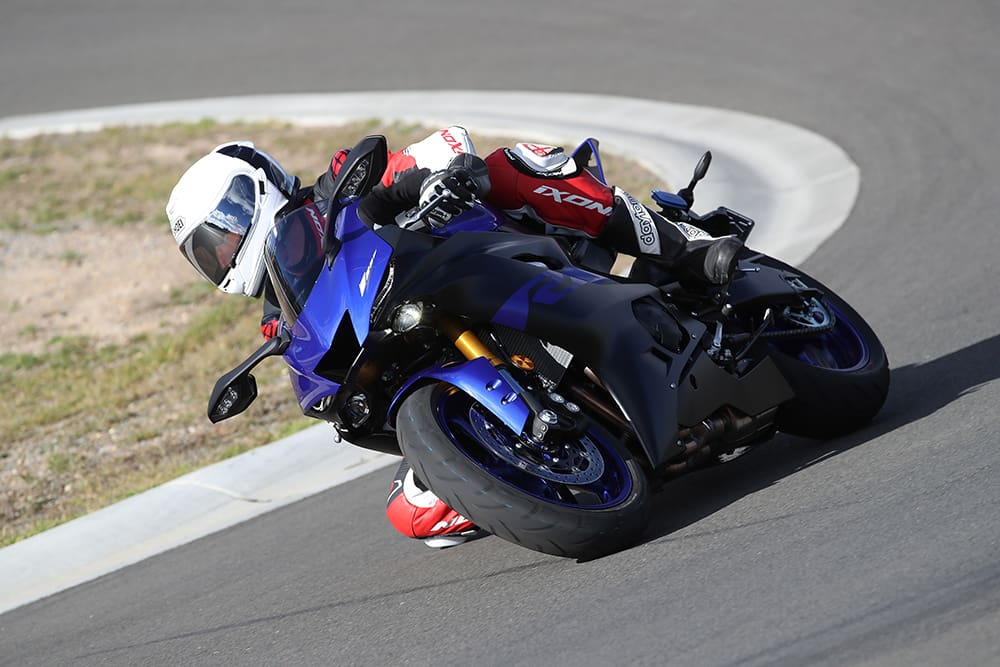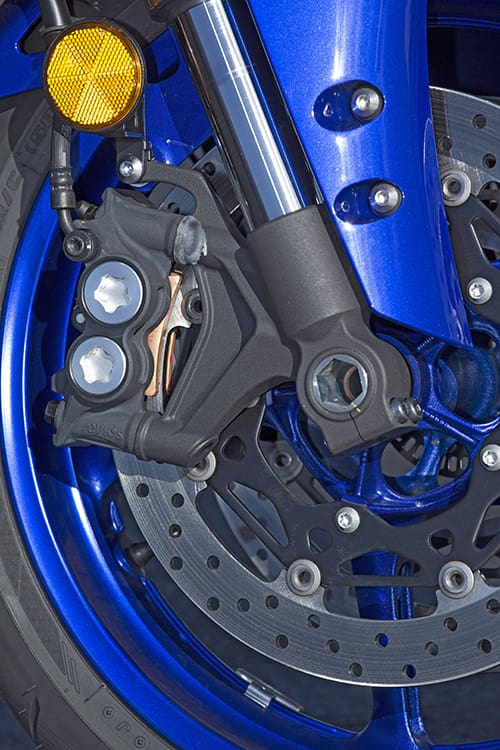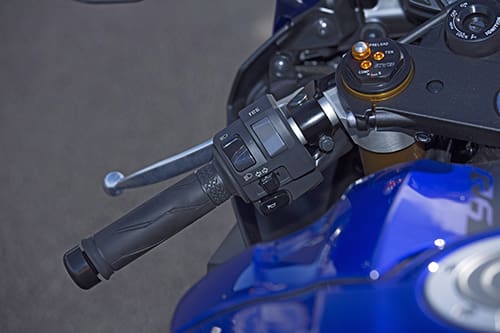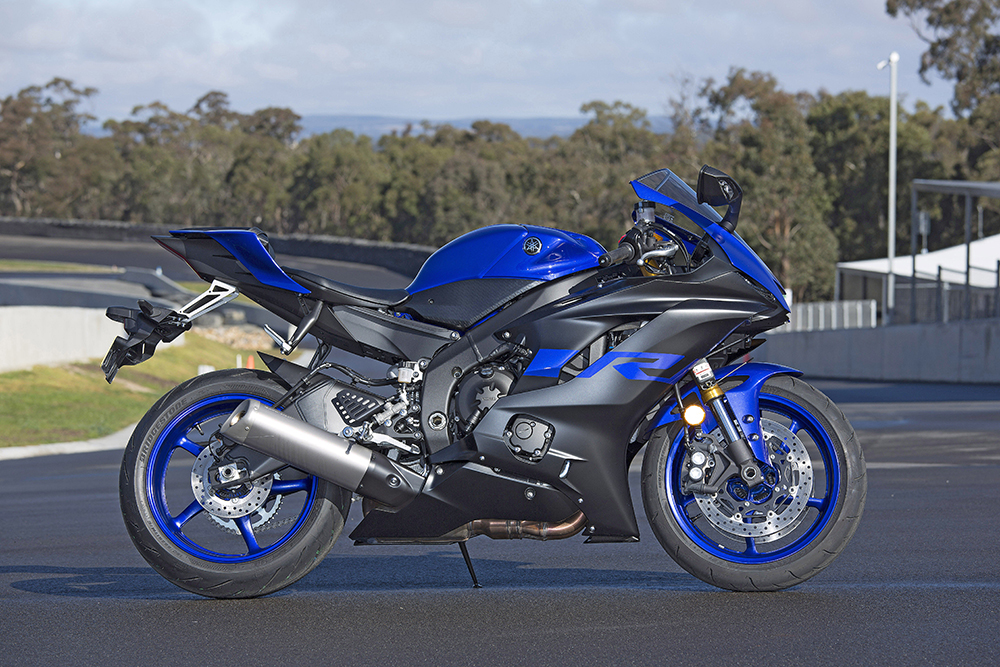Over the years, the Supersport category has produced some incredible machines, predominantly dominated by racebikes with lights and mirrors, so it’s no wonder that the manufacturers target on-track performance for this middleweight category.
Yamaha’s YZF-R6 has been an iconic machine that has been around for eons. Machines like the YZF-R6 are thoroughbred performers and certainly are best tested without the potential risk of the law putting a dampener on the fun. Our focus was to see how the 2019 Yamaha R6 rode in its natural habitat… the track.
After a major overhaul and the release of the 2017 R6, we are now in the third year of what is essentially the same bike. In 2019 we have two new colour schemes available, but the bike is fundamentally the same model. Yamaha currently has a competitive package in this model, so as the adage goes, if it ain’t broke, don’t fix it.
The R6 has clearly been shaped in its big brothers’ mould. The R1-derived looks and appeal are overwhelmingly obvious, and it screams fast. There is no doubt the R6 is a racetrack warrior. However track testing a bike invariably opens up a can of worms, the same worms you will never see, feel or even be aware of riding it on the street. The intention of giving the R6 a right flogging at the Pheasant Wood circuit, is to delve deeper into this current model’s strengths and weaknesses.

Perched on the R6, I thought either 600s are getting smaller or I’m getting older and less flexible! Back in 2004, my first four-stroke racebike was a YZF-R6, and I had epic flashbacks of myself riding what I thought was the most compact and precise machine ever built.
The 2019 version was a different kettle of fish entirely. Even just rolling out of pit lane it was clear that I was on the sharpest edge of the knife yet – the chassis felt amazing. Without exception, the handlebar to front wheel connection was the best I have sampled on any Supersport motorcycle. In fact it was so immediately impressive, it actually felt as though I was holding the front axle with my hands.
The next striking thing on the list was the chassis balance, which felt almost perfect, giving a very even feel between front and rear wheel.
This is a handling trait that suits the 600 perfectly and the reason for this is simple. A 600 relies on superior corner entry and mid-turn speed, to make up for its relative lack of power compared to a 1000cc machine. If you have too much front-end weight transfer, it will push the front tyre too hard and the transition from entry to mid-corner speed would then upset the balance. Although the new R6 still pitched forward on the brakes, it returned precisely and quickly back to its neutral balance mid corner once a trailing throttle was applied.
The engineers at Yamaha also tuned the balance to allow for a very predictable and tight corner exit as well. Change of direction was effortless as was trail braking deep into a corner. Even with stock rubber on the rims, braking right up to the apex with a knee on the ground was a breeze. This is a huge confidence building aspect of a well-rounded bike. The chassis geometry and suspension settings combine to produce a precise, nimble and predictable machine.
Yamaha also felt it was fitting to couple the same front braking system that you find on the R1 to the R6’s front end. After all, the bikes are not that far apart in weight, and 600s are a fast bit of kit these days. It would be inconceivable to hear a rider complain of brakes that are too good, so overkill here is welcomed.

Despite the lever position being too high, the ABS system had no lack of feel, with plenty of stopping power courtesy of dual 320mm rotors and four-piston calipers. At no time was there undue intervention from the ABS module, even with the braking forces on the racetrack.
For those of you that have experienced overprotective ABS, it can be quite daunting when the ECU is deciding how much brake you can have, rather than the rider calling the shots. The R6 passed with flying colours.
While the chassis was doing its turning, handling and braking in the right order, there were a few points drawing the overall impression down a few notches. I stand at 185cm tall and the R6 is not a bike that lends itself to a comfortable ride down to Phillip Island from the sunny Gold Coast. It is not a deal breaker by any means, remembering the R6 is a purpose-built machine, so you can’t expect both comfort and a race-winning pedigree.
Its tight ’peg-to-seat measurement makes it difficult for a lanky body to move around. The handlebar position relative to the seat is spacious, though, and puts the rider in an aerodynamic position, so not all is lost as far as the ergonomic triangle goes. But if your knees are well worn, there might be some discomfort.
Nowadays, electronics are coming as a standard item with almost every type of motorcycle, and as an apex predator, the R6 features a fantastic array of wires that offer multiple rider modes with different power options, as well as multiple traction-control settings. These are controlled by a simple switch on the handlebars, enabling the rider to cycle up and down through the levels of sensitivity. In the rain or on a changing surface, is where these rider aids will pay for themselves ten-fold.

The only disappointment the R6 suffers from electronically is its lack of a multidirectional quickshifter. Every bike is better with a two-way clutchless shift and the R6 experience, especially on a tight and twisty track like Pheasant Wood, would have been even better without the old-fashioned downshift throttle blip.
The R6 has typically always been a powerhouse. Some of my fondest memories on a racktrack have been aboard the humble R6, over the many years of its production. Unfortunately one of the biggest downfalls of the current model is its engine performance in standard guise on such a tight and twisty track.
The chassis-suspension combination allowed it to turn on a dime, but the engine lacked torque and punch, especially between 6000 and 9000rpm – right where you need it most to drive off a tight corner. But the gearbox did aid the situation a little, with its close ratios helping to keep the engine on the boil.
The R6 engine likes living life at the top end of the rev range, throwing down its peak power well into the double digits of the analogue tacho. The R6 suits a fast and flowing layout but it seemed to struggle to stay in its prime at Pheasant Wood. But the engine’s rotating mass was silky smooth and offered fantastic throttle response with close-to-perfect predictability.
Even opening and closing the throttle at high revs was easy and it didn’t have even the smallest on/off hesitations. It is these small subtleties that make a Supersport engine shine, and in turn only adds to the nimble and responsive nature of the chassis. In all of this, Yamaha’s most current version of its YZF-R6 performs in spades.
The current R6 is a two-wheeled delight, proving why it is a race-winning machine, both on the world stage and here in Australia. Although in standard form, not every track will suit particular types of machine, these types of tests show what normal road testing doesn’t.
Don’t let the small size and compact design of the Yamaha R6 lead you to any false conclusions. The bike has so much going for it, and as a middleweight contender has plenty of appeal. It has the looks of a supermodel and boasts a big screaming heart.












